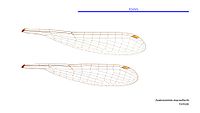Austrocnemis maccullochi
Appearance
| Tiny longlegs | |
|---|---|

| |
| Male tiny longlegs, Cairns | |

| |
| Female, Cairns | |
| Scientific classification | |
| Domain: | Eukaryota |
| Kingdom: | Animalia |
| Phylum: | Arthropoda |
| Class: | Insecta |
| Order: | Odonata |
| Suborder: | Zygoptera |
| Family: | Coenagrionidae |
| Genus: | Austrocnemis |
| Species: | A. maccullochi
|
| Binomial name | |
| Austrocnemis maccullochi | |

| |
Austrocnemis maccullochi is a species of damselfly in the family Coenagrionidae,[3] commonly known as a tiny longlegs.[4] It is a tiny damselfly, bronze-black in colour with very long legs.[4] It occurs across coastal northern Australia and New Guinea,[5] where it inhabits still waters.[6]
Gallery
-
Female wings
-
Male wings
See also
References
Wikimedia Commons has media related to Austrocnemis maccullochi.
- ^ Dow, R.A. (2017). "Austrocnemis maccullochi". IUCN Red List of Threatened Species. 2017: e.T87533424A87534076. doi:10.2305/IUCN.UK.2017-1.RLTS.T87533424A87534076.en. Retrieved 20 November 2021.
- ^ Tillyard, R.J. (1926). "On a collection of Papuan dragonflies (Odonata) made by the late Mr. Allan R. McCulloch in 1922–3, with descriptions of new species". Records of the Australian Museum. 15 (2): 157–166 [160]. doi:10.3853/j.0067-1975.15.1926.806.
- ^ "Species Austrocnemis maccullochi (Tillyard, 1926)". Australian Faunal Directory. Australian Biological Resources Study. 2012. Retrieved 7 April 2017.
- ^ a b Theischinger, Günther; Hawking, John (2006). The Complete Field Guide to Dragonflies of Australia. Collingwood, Victoria, Australia: CSIRO Publishing. p. 106. ISBN 978-0-64309-073-6.
- ^ Watson, J.A.L.; Theischinger, G.; Abbey, H.M. (1991). The Australian Dragonflies: A Guide to the Identification, Distributions and Habitats of Australian Odonata. Melbourne: CSIRO. ISBN 0643051368.
- ^ Theischinger, Gunther; Endersby, Ian (2009). Identification Guide to the Australian Odonata (PDF). Department of Environment, Climate Change and Water NSW. p. 200. ISBN 978-1-74232-475-3.



